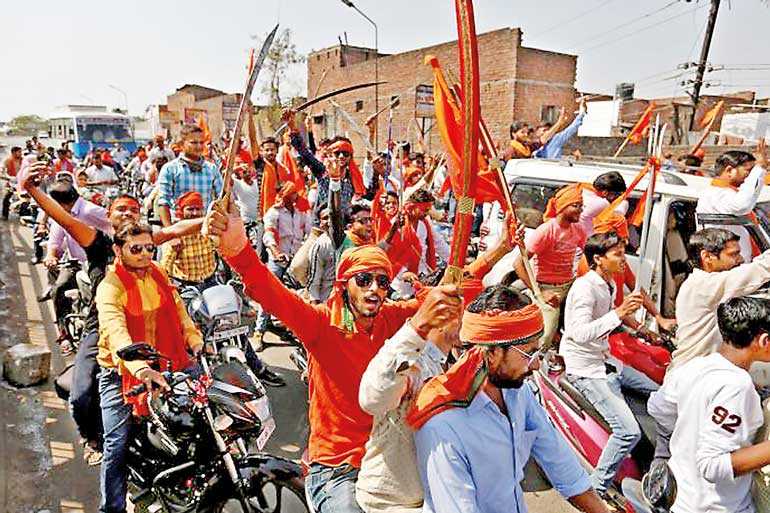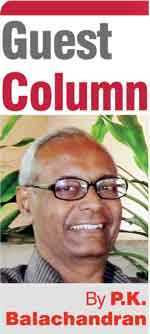Thursday Feb 13, 2025
Thursday Feb 13, 2025
Saturday, 15 December 2018 00:01 - - {{hitsCtrl.values.hits}}

Hindu Yuva Vahini demonstrating for building of the Lord Rama temple in Ayodhya in place of a 16th century mosque
Results of the recently-concluded State Assembly elections in Rajasthan, Madhya Pradesh, Chhattisgarh, Telangana and Mizoram show that economic and regional issues have upstaged “Hindutva” – the ideology of the ruling Bharatiya Janata Party (BJP) which is based on Hindu-majoritarian dominance over religious minorities, particularly the Muslims.
While economic issues were in the forefront in the Hindi-speaking Hindu majority North Indian States of Rajasthan, Madhya Pradesh and Chhattisgarh, regional identity issues were at the fore in Telangana and Mizoram, the former in South India and the later in the North East.
The Congress led by Rahul Gandhi upstaged the BJP in Rajasthan, Madhya Pradesh and Chhatisgarh, and regional parties the Telangana Rashtriya Samiti (TRS) and Mizo National Front (MNF) crushed national parties like Congress and BJP. Both national parties had failed to grasp and address regional sentiments which had both cultural and economic ingredients.
Hindutva, vigorously touted by the BJP and its affiliated organisations like the Rashtriya Swyamsewak Sangh (RSS), came a cropper or lost ground significantly even in States like Rajasthan, Madhya Pradesh and Chhatisgarh where it had been the dominant ideology for more than a decade.
Realising that it had failed to keep its promise to usher in “Achchey Din” (Good Days); that there had been economic progress without job generation; and that certain major decisions like demonetisation had backfired; BJP governments, both in the Center and the States, had revived the Hindutva movement to capture the imagination of the voters.
The BJP re-started a movement to build a temple for Lord Rama at Ayodhya at a place where a 16th Century mosque stood before it was demolished by Hindu fanatics on 6 December 1992.
Sakshi Maharaj, a BJP MP from Uttar Pradesh (where Ayodhya is located) rekindled his demand that all major mosques, including the celebrated Jama Masjid in Delhi, should be demolished because these were, according to him, built on demolished Hindu temples.
“I am 100% sure that underneath each of these mosques there will be a Hindu idol,” he asserted.
Since antagonism towards minority Muslims is the foundation on which Hindutva is based, eating beef or carrying beef or transporting cattle for slaughter were subjected to vigilante attacks. Mobs of Hindu fanatics publicly lynched Muslims often on an unfounded basis in various parts of India.
The Hindustan Times quoted the IndiaSpend website to say that between 2010 and 2017, 86% of 28 Indians killed in 63 incidents of cow-related violence, were Muslims. And 97% of these attacks were reported after Narendra Modi became Prime Minister in May 2014. About half the cow-related violence – 32 of 63 cases – were reported from States governed by the BJP.
Reasons for defeat
But Hindutva propaganda and actions of its vigilante groups failed to sway voters in Rajasthan, Madhya Pradesh and Chhattisgarh this time round.
Substantial sections had veered away from the BJP. These were worried about their economic condition which had gone from bad to worse during Modi’s rule at the Center and the BJP’s rule in their States.
According to IndiaSpend between 2004 and 2016, Madhya Pradesh had recorded 16,932 farmer suicides—more than three every day. The count was the fourth highest nationwide. And BJP had been ruling Madhya Pradesh since 2003.
Chhattisgarh followed with 12,979 suicides—nearly three every day. It was fifth highest, nationwide. And BJP had been ruling the State since 2003. Rajasthan ranked the 11th highest with 5,582 suicides during the same period.
The BJP Government’s only answer to agrarian distress has been to raise the Minimum Support Price (MSP). But the MSP, even if delivered efficiently, has only been a palliative and an inadequate one at that.
The farm sector’s problems stem from its adverse terms of trade with the industrial sector; price fluctuations due to natural and man-made causes; the role played by middlemen; and the lack of credit and local storage facilities. MSP is not a medicine for this illness.
Both the urban and the rural populations suffered due to the sudden demonetisation in 2016. Stress due to demonetisation, which made 86% of Indian currency worthless all of a sudden, led to more than 100 suicides. At least 1.5 million lost their jobs and 150 million were without pay for weeks.
Demonetisation was a comprehensive failure in terms of its goal, which was to unearth black money. In India, ill-gotten cash is converted into shares, gold and real estate or stashed away abroad. In 2014, Modi promised to put all the black money unearthed into people’s accounts with each Indian getting a bonanza of Indian Rs. 15 lakh. But the poor man’s money in the bank only dwindled, while the rich and the influential looted the banks and absconded.
When he came to power with a massive majority in 2014, Modi promised to generate 20 million jobs a year. But more than 7.2 million jobs meant for the 15-24 age group “were lost” over the last four years. Job creation in India is at an eight-year low. This created an undercurrent of anger in the middle classes.
New investment is the lowest in 13 years. Bank credit growth had sunk to a 63-year low. The rich looted the State banks and scooted. The $ 1.77 billion Punjab National Bank (PNB) scam hit the Indian banking sector very hard. But Nirav Modi a Modi cohort, who was involved, fled the country without repaying his debts. In February 2016, billionaire Vijay Mallya, who siphoned off $ 1.4 billion, fled to the UK allegedly with Government connivance.
In October 2017, bad bank loans and Non-Performing Assets (NPAs), stood at $ 145.6 billion. This accounted for 12.6% of the total loans given by the nationalised banks. NPAs in nationalised banks accounted for about 87% of gross NPAs by the end of March 2017. This meant that Modi was responsible.
Cozying up to the corporate sector, while turning a blind eye and a deaf ear to the farmers’ and the middle income groups’ plight, the BJP Government had written off loans to the corporate sector to the tune of $ 31 billion.
Fruitless trips abroad
According to information collected through the Right To Information Act, Modi had made 41 trips to over 50 countries in the first four years of office, spending 165 days away from India. All that was ostensibly for attracting Foreign Direct Investment (FDI) for his much-touted ‘Make in India’ project.
But the results were woefully short of the promise. Since the announcement of ‘Make in India’ on 15 August 2015, there is no evidence that manufacturing has gathered momentum. On the contrary, it seems to have lost steam. In 2016-17, the manufacturing sector had weakened considerably.
Foreign Direct Investment
There has definitely been a spike in Foreign Direct Investment (FDI) into India since Modi assumed power in 2014. But FDI has not been going into the manufacturing sector which at once strengthens the economy and generates employment.
The Services have attracted $ 64 billion in FDI, 17.42% of total. This sector comprises financial services, banking, insurance, non-financial/business services, outsourcing, research and development, courier, technology testing analysis.
Telecommunications has attracted $ 30 billion in FDI, 8.18% of total. Computer software and hardware have attracted $ 29.8 billion in FDI, 8.11% of total.
Overall, the impact of FDI on employment generation has been poor. The rural economy has not gained. Rural distress has worsened and the urban-rural divide has widened.
Unless Prime Minister Modi and his Government address these issues in the next five months, defeat in the May 2019 parliamentary elections cannot be ruled out.
Discover Kapruka, the leading online shopping platform in Sri Lanka, where you can conveniently send Gifts and Flowers to your loved ones for any event including Valentine ’s Day. Explore a wide range of popular Shopping Categories on Kapruka, including Toys, Groceries, Electronics, Birthday Cakes, Fruits, Chocolates, Flower Bouquets, Clothing, Watches, Lingerie, Gift Sets and Jewellery. Also if you’re interested in selling with Kapruka, Partner Central by Kapruka is the best solution to start with. Moreover, through Kapruka Global Shop, you can also enjoy the convenience of purchasing products from renowned platforms like Amazon and eBay and have them delivered to Sri Lanka.
Discover Kapruka, the leading online shopping platform in Sri Lanka, where you can conveniently send Gifts and Flowers to your loved ones for any event including Valentine ’s Day. Explore a wide range of popular Shopping Categories on Kapruka, including Toys, Groceries, Electronics, Birthday Cakes, Fruits, Chocolates, Flower Bouquets, Clothing, Watches, Lingerie, Gift Sets and Jewellery. Also if you’re interested in selling with Kapruka, Partner Central by Kapruka is the best solution to start with. Moreover, through Kapruka Global Shop, you can also enjoy the convenience of purchasing products from renowned platforms like Amazon and eBay and have them delivered to Sri Lanka.